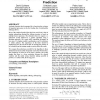Free Online Productivity Tools
i2Speak
i2Symbol
i2OCR
iTex2Img
iWeb2Print
iWeb2Shot
i2Type
iPdf2Split
iPdf2Merge
i2Bopomofo
i2Arabic
i2Style
i2Image
i2PDF
iLatex2Rtf
Sci2ools
GECCO
2005
Springer
2005
Springer
Evolutionary rule-based system for IPO underpricing prediction
Academic literature has documented for a long time the existence of important price gains in the first trading day of initial public offerings (IPOs). Most of the empirical analysis that has been carried out to date to explain underpricing through the offering structure is based on multiple linear regression. The alternative that we suggest is a rule-based system defined by a genetic algorithm using a Michigan approach. The system offers significant advantages in two areas, 1) a higher predictive performance, and 2) robustness to outlier patterns. The importance of the latter should be emphasized since the non-trivial task of selecting the patterns to be excluded from the training sample severely affects the results. We compare the predictions provided by the algorithm to those obtained from linear models frequently used in the IPO literature. The predictions are based on seven classic variables. The results suggest that there is a clear correlation between the selected variables and ...
| Added | 27 Jun 2010 |
| Updated | 27 Jun 2010 |
| Type | Conference |
| Year | 2005 |
| Where | GECCO |
| Authors | David Quintana, Cristóbal Luque del Arco-Calderón, Pedro Isasi |
Comments (0)

